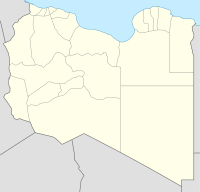Giado concentration camp
Location of the Giado concentration camp |
The Giado concentration camp (also known as the Jado concentration camp ) was an Italian concentration camp near the city of Jadu south of Tripoli in Italian Libya , which in 1942 and 1943 was mainly used to intern Libyan Jews .
background
In Italy there had been racial laws since 1938 that defined and discriminated against people as Jews. In Italian Libya they were applied less strictly because the Italian governor Italo Balbo did not want to jeopardize the economic contribution of the Jews in the colony. This policy continued even after his death in 1940. The German side also saw the advantages that could be drawn from pragmatic economic cooperation with the Jewish population.
Due to the course of the African campaign, in which the Cyrenaica and the port city of Benghazi were contested several times and the troops of the United Kingdom and the Commonwealth were celebrated as liberators by the Jewish side, the Jews were viewed by the Italians as collaborators and a security risk. They were therefore to be deported as part of the sfollamento , whereby the Jews with foreign passports were first brought to camps. From January 1942 onwards, the Libyan Jews from Cyrenaica were mainly deported to the infamous Giado camp near the Tunisian border.
camp
From January 1942, Jews were taken to the Giado concentration camp, a former barracks, by truck. Many died of heat and thirst on the days of driving. By June 1942, 2,537 Libyan and 47 Italian Jews from Cyrenaica had arrived in Giado. Another 380 Jews followed later. The living conditions and nutrition in the camp were very poor and the male prisoners were forced to do hard labor. 562 people died of epidemics, physical exhaustion and malnutrition, but also of abuse by the Italian guards. The camp commanders were Italians; the guards consisted of Italian and Arab police officers.
Shortly after the defeat of El Alamein , orders came to kill all inmates before the camp was evacuated. The healthy prisoners had to line up in front of machine guns on the roll call square; the sick were to be burned in the barracks. After waiting hours for confirmation of the order, however, a counter-order came.
On January 24, 1943, the camp was liberated by the British and the prisoners looked after and looked after. With funds from the American Jewish Joint Distribution Committee , the repatriation of the survivors to their homeland was accelerated and the British were relieved of the financial burden.
Anglo-Libyan Jews
Around 500 Jews with British citizenship who emigrated to Libya, mainly from Gibraltar and who were imprisoned in the Giado concentration camp, were deported to Italy while the camp was in existence. The deportees, regarded by the fascist government as citizens of an enemy state and by the National Socialists as supposed "exchange goods", were initially interned at various locations in Italy. After the German occupation of Italy in September 1943, they were deported from their internment locations in Italy via the Fossoli transit camp to the Bergen-Belsen concentration camp; a smaller part ended up in the Reichenau camp near Innsbruck . Some of the deportees from Bergen-Belsen were eventually taken to Auschwitz and murdered there. A smaller group was transferred to the Lindele camp near Biberach an der Riss in 1944 and released in exchange for German prisoners of war. While another smaller group ended up in the Vittel camp in France and was liberated there by the Allies.
reception
The Italian fascism research of the post-war period is accused of a rather belittling research position, which is revised by the research of the journalist Eric Salerno.
literature
- Eric Salerno: Uccideteli tutti. Libia 1943: Gli ebrei nel campo di concentramento fascista di Giado; una storia italiana . Il Saggiatore, Milan 2008, ISBN 978-88-428-1471-9 .
- Israel Gutman et al. (Ed.): Encyclopedia of the Holocaust . Munich and Zurich 1995, ISBN 3-492-22700-7 , vol. 2, p. 842 - keyword "Labor and internment camps in Libya"
- Yitzchak Kerem: Rescue or Annihilation: Italian Occupation Forces and the Jews in World War II , in: Stanislao G. Pugliese: The Most Ancient of Minorities: the Jews of Italy . Greenwood Press, Westport, Connecticut, 2002 ISBN 0-313-31895-6 , pp. 275-288, here pp. 282ff.
Web links
- Sheryl Ochayon: The Jews of Libya , The International School for Holocaust Studies, Yad Vashem
Individual evidence
- ↑ Maurice M. Roumani: The Jews of Libya . Sussex Academic Press 2007, ISBN 978-1-84519-137-5 , pp. 26 f.
- ↑ Maurice M. Roumani: The Jews of Libya . P. 30.
- ↑ Maurice M. Roumani: The Jews of Libya . P. 28.
- ↑ Maurice M. Roumani: The Jews of Libya . P. 34 f.
- ^ A b c Patrick Bernhard: Review by: Eric Salerno: "Uccideteli tutti" . Libia 1943: gli ebrei nel campo di concentramento fascista di Giado, Milan: Il Saggiatore 2007, in: Sehepunkte 8 (2008), no.12.
- ^ Israel Gutman et al. (Ed.): Encyclopedia of the Holocaust . Munich and Zurich 1995, ISBN 3-492-22700-7 , Vol. 2, p. 842.
- ↑ Maurice M. Roumani: The Jews of Libya . P. 35.
- ↑ Michele Strazza: Giado, un campo di concentramento in Libia. In: win.storiain.net. Retrieved February 3, 2020 (Italian).
- ^ Anna Pizzuti: Ebrei stranieri internati in Italia durante il periodo bellico. In: annapizzuti.it. Retrieved February 3, 2020 (Italian).
